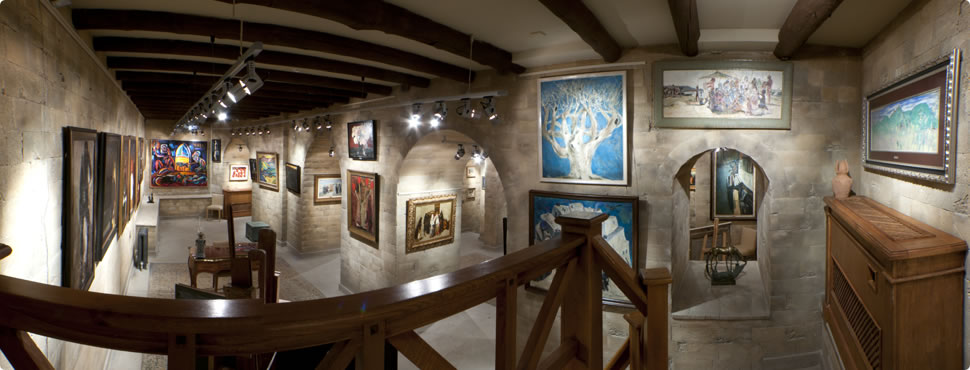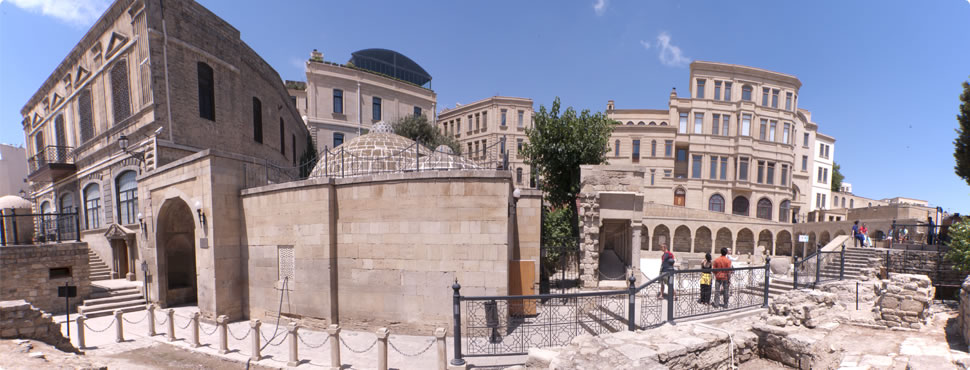Nar art gallery opened to the public in 2005. The gallery was conceived by Farkhad Akhmedov, businessman, politician, patron of the arts, and a man infinitely in love with art. Over the years, he has invested considerably in collecting artworks from all over the world. In Azerbaijan, Farkhad Akhmedov consistently, piece by piece, assembled his unique collection of the Azerbaijani school of painting, which includes works of various artistic movements of the twentieth century.

While purchasing artworks by well-known Azerbaijani artists, guided by his fine intuition, Akhmedov collected the paintings of Azerbaijani non-conformist artists, along with classic works by recognized artists. His collection of paintings includes such venerable artists as Sattar Bakhlulzade, Mikayil Abdullayev, Abdul Khalig, Beyukaga Mirzazade, Maral Rakhmanzade, Khalida Safarova, Mahmud Taghiyev, Togrul Narimanbekov, Tahir Salakhov, Farkhad Khalilov, Ashraf Murad, Javad Mirjavadov, Rasim Babayev, Tofik Javadov, Udjal Hagverdiyev, Eliar Alimirzoyev, and many others whose names are included in the treasury of Azerbaijani Art. The first painting Akhmedov owned was Pomegranates (Narlar in Azeri) by Togrul Narimanbekov, which inaugurated the gallery collection, and in whose honour the gallery is named.
As the years have passed, the paintings collection has become more impressive. Farkhad Akhmedov decided to establish a permanent display that is accessible to all lovers of painting. He found a suitable venue in the heart of Baku, in Icheri Sheher – the Inner City, at Asaf Zeynalli Str. This two-storey building, like most in Icheri Sheher, has its own history. In ancient times, it was a Zoroastrian fire temple. The ‘Lenkoran’ hotel was erected on the site in 1878. Later, in Soviet times, the building was a police department. Its basement space was not used at all, and was buried under the archeological layers of past eras. Recently, the completion of archaeological excavations and restoration works has unearthed spacious premises in which a series of inlaid semicircular arches lead to a succession of multi-level halls. And now it is the residence of the gallery’s masterpieces that, like the ancient city of Baku, remain timeless.

For more than 10 years, Nar Gallery has delighted true art lovers. Its collection is constantly updated, and the gallery is expanding its activities. Yet its paintings aren’t always on display. They are part of international group shows, representing the art of Azerbaijan at prestigious exhibition venues, including Sotheby’s and the Saatchi Gallery in London, as well as in Biennale Arte 2015 in Venice – the most significant international exhibition of contemporary art in the world.
Nar Gallery houses a permanent collection of more than 300 of Azerbaijani paintings. It boasts a collection of paintings by Azerbaijani artists relating to different art trends of the twentieth century, from realism to modernism. Paintings by nonconformists, who often became known only after their deaths, comprises the basis of the Nar collection. Among them is Ashraf Murad, the artist of tragic fate who passed away prematurely, and whose paintings had to be recovered from private collections in Azerbaijan and abroad. Today Nar Gallery preserves the most significant collection of works by this outstanding artist, a brilliant representative of the Azerbaijani avant-garde.
In Azerbaijan in the late 1950s and early 1960s, there was a group of artists who were conceptually and stylistically expanding the narrow confines of socialist realism. Sattar Bakhlulzade, Mikayil Abdullayev, Beyukaga Mirzazade, Khalida Safarova, Mahmud Taghiyev and many others were able to create original masterpieces characterized by virtuosity of style, refinement of color, and depth of philosophical thought. The gallery presents paintings of various genres: industrial and lyrical landscapes, portraits of contemporaries and politicians, genre scenes dedicated to labour and sport, and uniquely colored still lifes.
It is difficult to single out the most significant paintings kept in the Nar Gallery. There are no minor paintings exhibited here. Everyone who comes here takes away something close and harmonious to his or her soul. One person will be impressed by the subtle charm of Mikayil Abdullayev’s Cotton Harvesting, with its refined sense of color and lovely graceful figures of girls. Another will note Sattar Bakhlulzade’s landscapes, rich with poetry and romanticism, while someone else cannot remain indifferent to Tahir Salakhov’s severe painting style.
One of the most important paintings in the gallery is Wedding by Javad Mirjavadov, a rebel of gigantic spirit, whose powerful talent intertwined the everyday and the mystical, the routine and phantasmagoria. Attention must also be drawn to the Chaykhana series by Togrul Narimanbekov, whose work is permeated by the spirit and symbols of Azerbaijani folklore.
F. Akhmedov has also collected masterpieces by Gennady Brijatyuk, an artist of extraordinary talent. One of this brilliant colorist’s most renowned paintings is Nude, with its effective combination of sparkling, phosphorescing hues: a color like thin porcelain; the flexible slender waist of the girl depicted as if illuminated by an interior light and shaded by turquoise and shining gold — the composition as a whole amazes with its harmony and perfection.
Farkhad Khalilov offers spectators his own version of Absheron. His Pink Bush is not just a landscape, but also a symbol of life, a symbol of the inexhaustible fertility of the blossoming land.
The Nar Gallery collection also features works by Museib Amirov, Eliar Alimirzoyev, Shamo Abasov, Sabina Shikhlinskaya, Melik Agamalov, Udjal Hagverdiyev, and other artists of the post-Soviet generation. All of them discovered their own artistic and figurative style, and related their concerns in a bright and original manner. The gallery has a rich collection of paintings and graphics by Shamo Abasov, an outstanding artist of the post-Soviet epoch. The Nar Gallery’s collection of works by artists of the past century and today can be likened to the stars that will shine for many years, making our world brighter and more harmonious by a light that never dies away.
